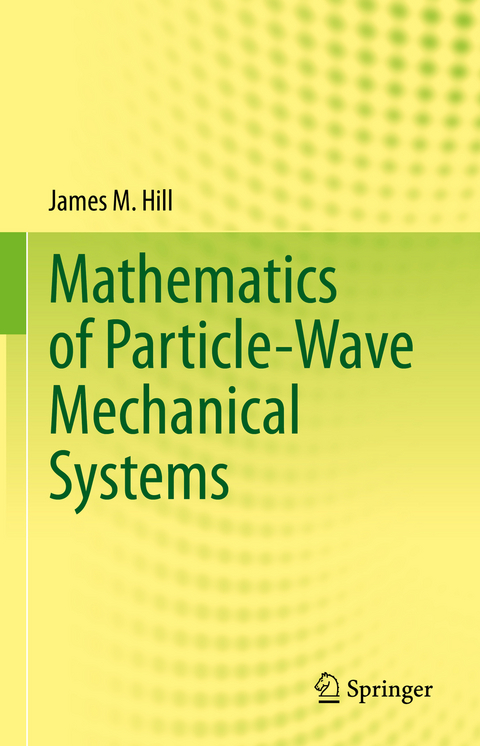
Mathematics of Particle-Wave Mechanical Systems
Seiten
2022
Springer International Publishing (Verlag)
9783031197925 (ISBN)
Springer International Publishing (Verlag)
9783031197925 (ISBN)
Despite successes of modern physics, the existence of dark energy and matter is indicative that conventional mechanical accounting is lacking. The most basic of all mechanical principles is Newton's second law, and conventionally, energy is just energy whether particle or wave energy. In this monograph, Louis de Broglie's idea of simultaneous existence of both particle and associated wave is developed, with a novel proposal to account for mass and energy through a combined particle-wave theory. Newton's second law of motion is replaced by a fully Lorentz invariant reformulation inclusive of both particles and waves.
The model springs from continuum mechanics and forms a natural extension of special relativistic mechanics. It involves the notion of "force in the direction of time" and every particle has both particle and wave energies, arising as characteristics of space and time respectively. Dark matter and energy then emerge as special or privileged states occurring for alignments of spatial forces with the force in the direction of time. Dark matter is essentially a backward wave and dark energy a forward wave, both propagating at the speed of light. The model includes special relativistic mechanics and Schrödinger's quantum mechanics, and the major achievements of mechanics and quantum physics.
Our ideas of particles and waves are not yet properly formulated, and are bound up with the speed of light as an extreme limit and particle-wave demarcation. Sub-luminal particles have an associated superluminal wave, so if sub-luminal waves have an associated superluminal particle, then there emerges the prospect for faster than light travel with all the implications for future humanity. Carefully structured over special relativity and quantum mechanics, Mathematics of Particle-Wave Mechanical Systems is not a completed story, but perhaps the first mechanical model within which such exalted notions might be realistically and soberly examined. If ultimately the distant universe become accessible, this will necessitate thinking differently about particles, waves and the role imposed by the speed of light. The text constitutes a single proposal in that direction and a depository for mathematically related results. It will appeal to researchers and students of mathematical physics, applied mathematics and engineering mechanics.
The model springs from continuum mechanics and forms a natural extension of special relativistic mechanics. It involves the notion of "force in the direction of time" and every particle has both particle and wave energies, arising as characteristics of space and time respectively. Dark matter and energy then emerge as special or privileged states occurring for alignments of spatial forces with the force in the direction of time. Dark matter is essentially a backward wave and dark energy a forward wave, both propagating at the speed of light. The model includes special relativistic mechanics and Schrödinger's quantum mechanics, and the major achievements of mechanics and quantum physics.
Our ideas of particles and waves are not yet properly formulated, and are bound up with the speed of light as an extreme limit and particle-wave demarcation. Sub-luminal particles have an associated superluminal wave, so if sub-luminal waves have an associated superluminal particle, then there emerges the prospect for faster than light travel with all the implications for future humanity. Carefully structured over special relativity and quantum mechanics, Mathematics of Particle-Wave Mechanical Systems is not a completed story, but perhaps the first mechanical model within which such exalted notions might be realistically and soberly examined. If ultimately the distant universe become accessible, this will necessitate thinking differently about particles, waves and the role imposed by the speed of light. The text constitutes a single proposal in that direction and a depository for mathematically related results. It will appeal to researchers and students of mathematical physics, applied mathematics and engineering mechanics.
James M. Hill, Emeritus Professor, University of Wollongong; Adjunct Professor, University of South Australia
Introduction.- Special Relativity.- General Formulation and Basic Equations.- Special Results for One Space Dimension.- Exact Wave-Like Solution.- Derivations and Formulae.- Lorentz and Other Invariances.- Further Results for One Space Dimension.- Centrally Symmetric Mechanical Systems.- Relation with Quantum Mechanics.- Coordinate Transformations, Tensors, and General Relativity.- Conclusions, Summary, and Postscript.
| Erscheinungsdatum | 02.12.2022 |
|---|---|
| Zusatzinfo | XIV, 378 p. 6 illus. |
| Verlagsort | Cham |
| Sprache | englisch |
| Maße | 155 x 235 mm |
| Gewicht | 745 g |
| Themenwelt | Mathematik / Informatik ► Mathematik |
| Naturwissenschaften ► Physik / Astronomie ► Relativitätstheorie | |
| Naturwissenschaften ► Physik / Astronomie ► Theoretische Physik | |
| Schlagworte | dark energy • Dark Matter • de Broglie States • Klein-Gordon equation • Mathematics of Particle-Wave Mechanics • Newton's Second Law • Particle-Wave Mechanics • Special relativity |
| ISBN-13 | 9783031197925 / 9783031197925 |
| Zustand | Neuware |
| Informationen gemäß Produktsicherheitsverordnung (GPSR) | |
| Haben Sie eine Frage zum Produkt? |
Mehr entdecken
aus dem Bereich
aus dem Bereich
Eine Einführung in die Allgemeine Relativitätstheorie
Buch | Softcover (2023)
De Gruyter Oldenbourg (Verlag)
CHF 97,90
Von Null auf Lichtgeschwindigkeit
Buch | Softcover (2021)
De Gruyter Oldenbourg (Verlag)
CHF 89,95
The Worlds of Albert Einstein
Buch | Hardcover (2025)
Oxford University Press Inc (Verlag)
CHF 26,15


